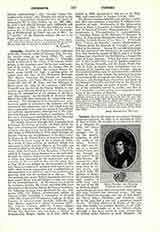

Teneriffe, DIOCESE of (TENERIFENSIS), suffragan of Seville, formerly called Nivariensis from Nivaria, the ancient name of the island (Pliny, VI, xxxii; Filippo Bergamo, XVI,” sup. chronic.”). Teneriffe, which is situated in the center of the Canary Archipelago, is the principal, most fertile, and most populous of the islands. It contains the famous Pico de Teyde (Peak of Teneriffe), the ancient Mount Atlante, rising 12,200 feet high, a guiding point for sailors since the time of the Phoenician Hercules. This diocese comprises the Islands of Teneriffe, Palma, Gomera, and Ferro (Hierro), is situated between 13° and 16° W. long., and has belonged to Spain since the time of its conquest, 1402-1496. Teneriffe was the last of the Canary Islands to surrender; more Spanish blood was shed in its conquest than in the subjugation of the empires of the Incas and Montezumas. In the battle of Acentejo alone 900 of the 1120 who composed the conquering army were lost. The aborigines, of the Guanche race, were, however, quick to assimilate the manners and the customs of the conquerors, and if this island were the last to surrender, it was soon the center of the political and military organizations, although not of the ecclesiastical, because of the unexpected translation of the first see in the Canaries from Rubicon on the Island of Lanzarote to Las Palmas of the Gran Canaria.
The people, however, through their representatives petitioned the Cortes of Cadiz (September 14, 1813) for their own ecclesiastical administration. It is interesting to note that it was one of these representatives, who, being at Philadelphia in 1788, urged through the Nuncio Vincenti the establishment of the first Catholic diocese in the United States of America (Diario de las Cortes de Cadiz lesion de 18 de Enero de 1813). As a result of their petition an auxiliary bishop was appointed in 1816, and the Diocese of Teneriffe was erected in 1819 by the Bull of Pius VII dated February 1, 1818, the Church of Los Remedios at San Cristobal de la Laguna being designated as the cathedral. In 1823 the Nuncio Mastai Ferreti, during his voyage to Chile, was impressed by the importance and the necessity of this see, and on this account when later as Pius IX he was obliged by the Concordat of 1851 with Spain to suppress it, he did so with regret, and in 1876, when certain concessions and modifications of this concordat were solicited, one of the conditions for granting them was the restoration of this see. This was granted, but, as the Bull of suppression had never been issued, Rome was not obliged to take any steps for the reestablishment. In the ninety-two years of its existence, besides the vicars capitular who have administered the diocese during the time of vacancies, the following bishops have governed the see: Folgueras Sion, first bishop, academician, author of various works, including a translation of Juvenal (1825-48); Lluch and Urquinaona, bishops of Gran Canaria, as administrators Apostolic (1825-48); Infante Macias, author of a volume of sermons (1877-82); Cervera Cervera (1882-4); Torrijos Gomez (1888-94); and since 1894 the present bishop, Msgr. Nicolas Rey Redondo, who was born at Melgar de Fernamental, Burgos, Spain, on January 6, 1834, ordained in 1860, appointed to this see on May 21, 1894, and consecrated at Burgos, September 9, 1894. The diocese numbers 208,000 souls, and has a cathedral, fifty-nine parishes, a seminary, 6 religious communities of men: Missionaries of the Immaculate Heart of Mary, 1; Lazarists, 3; Christian Brothers, 2; and 14 houses of women: Dominicanesses, 1; Franciscanesses, 1; Conceptionists, 1; Assumptionists, 1; Teaching Sisters of St. Dominic, 2; Servants of Mary, 3; Franciscan Hospitaller Sisters, 1; Sisters of Charity, 3; Little Sisters of the Poor, 1. A Catholic daily, “Gaceta de Tenerife”, and the official bulletin, “Buletin oficial del obispado de Tenerife”, are published in the diocese. Among the notable personages who are natives of this island may be mentioned the Ven. Jose Anchieta, apostle of Brazil, and Ven. Pedro Bethancourt, founder of the Bethlemites, a hospitaller order of Latin America. It has also given two martyrs to the Church, Fray Luis de Aguirre, Augustinian, in Guecija, Granada, and the Jesuit, Pedro Parrado de Leon, in Japan, three archbishops, and ten bishops, six to America and four to Europe. Among the notable buildings may be mentioned the cathedral rebuilt by the present bishop, the parochial churches of La Concepcion of Laguna, and those of Santa Cruz, Orotava, and Realejo-bajo, Garachico and Icod on the Island of Teneriffe, and Salvador on the Island of Palma, all containing art works of merit. The pulpit of the cathedral, carved in marble, and that of La Concepcion, a wood carving, bear comparison with those of the churches of Brussels.
JOSE RODRIGUEZ MOURE

